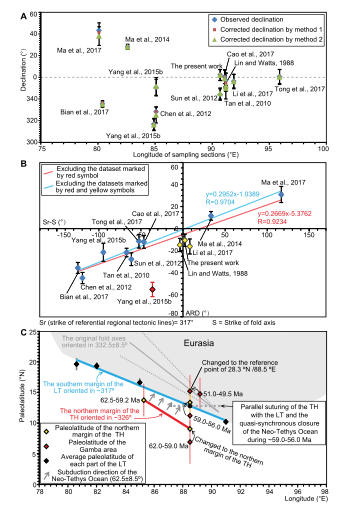91855216-GSA:New Late Cretaceous paleomagnetic results from the Lhasa terrane and their implications for the suturing of India and Eurasia and the closure of the Neo-Tethys Ocean
ABSTRACT
The forms of the margins of the Lhasa terrane and the Tethyan Himalaya prior to the collision of India and Eurasia as constrained by paleomagnetism are ambiguous due to the disordered Cretaceous paleomagnetic data from the central Lhasa terrane and the counterclockwise rotation of the Indian plate during the Cretaceous. This ambiguity has induced controversy over the processes of suturing of India and Eurasia and the closure of the Neo-Tethys Ocean. We obtained a set of high-quality Late Cretaceous paleomagnetic data from the central Lhasa terrane, which, integrated with reliable Cretaceous and Paleogene paleomagnetic data sets from the other parts of the Lhasa terrane and Tethyan Himalaya, confirmed that the southern margin of the Lhasa terrane and the northern margin of the Tethyan Himalaya were originally oriented ∼317° and
∼326°, respectively, prior to the collision of India and Eurasia. The margins of the Lhasa terrane and Tethyan Himalaya were almost consistent with the original straight fold axes of Cretaceous strata in the southern part of the Lhasa terrane, which were oriented 332.5° ± 8.5°, indicating that the subduction of the Neo-Tethys Ocean beneath Eurasia and the movement of the Tethyan Himalaya consistently maintained a stabilized direction of 62.5° ± 8.5° during the Late Cretaceous. The different kinematic characteristics of the Indian plate and Tethyan Himalaya and the overlap of the margins of the Tethyan Himalaya and Lhasa terrane during 59.0–56.0 Maindicate that the Tethyan Himalaya was already rifted from the Indian plate prior to62.5–59.2 Ma, and then it quasi-parallelly collided with the Lhasa terrane during 59.0–56.0 Ma, quasi-synchronously closing the Neo-Tethys Ocean.

.png)
